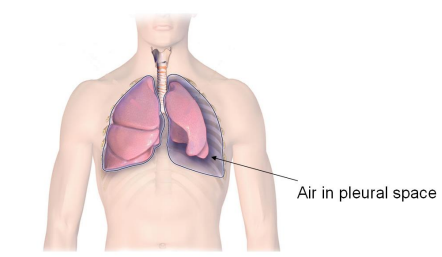What is a Pneumothorax?
What is a pneumothorax?
A pneumothorax is a condition where air has leaked from the lung into the pleural space (the space between the lung and the chest wall). This may cause the lung to partially or fully collapse, and symptoms may vary from mild to severe chest pain and/or shortness of breath.

Why have I had a pneumothorax?
Pneumothorax may be due to an injury (traumatic), or a medical procedure (iatrogenic). However, they can also happen for no obvious reason (spontaneous). Pneumothorax is more common in men than women, and they are up to 120 times more likely to occur in smokers than non-smokers.
There is no evidence that physical activity itself is a cause of pneumothorax, and they are just as likely to occur while at rest. If you have normal lungs, it is called a primary pneumothorax. If you have a diagnosis of lung disease, it is called a secondary pneumothorax, and is more likely to
cause significant symptoms.
What should be done about my pneumothorax?
This depends on several factors, such as how big it is, and how significantly it affects you. If it is large or you have significant symptoms, then it is likely you will need a chest drain, which is a tube that is inserted through the chest wall and into the pleural space to allow the air to drain safely so the lung can re-expand. In some cases, a procedure called an aspiration can be performed, where some of the air is removed to relieve the pressure. You may be allowed to go home following this procedure if it is successful. In cases of minor pneumothorax, you may be discharged home without requiring an aspiration. All cases of pneumothorax will need to be followed up by a respiratory physician with repeat chest x-rays.
What happens next?
If your pneumothorax is minor, or you have had it aspirated, you can be discharged home if the doctor looking after your care feels it is safe. You will have follow up arranged, usually within two to four weeks, and will be reviewed by a doctor, with a repeat chest x-ray to ensure that things are resolving as expected.
What should I do when I go home?
As there is no link between physical exertion and occurrence of pneumothorax, you should be able to return to work and normal activities once your symptoms have resolved. It is advised that sports involving extreme exertion and physical contact should not be resumed until complete recovery, as advised by your doctor at your review.
It is not safe to fly with a pneumothorax as air expands due to lower pressures at high altitudes, which could cause the pneumothorax to increase in size. You should not fly until at least one week after your pneumothorax has FULLY resolved.
Following a spontaneous pneumothorax you will not be allowed to SCUBA dive ever again, unless you have a definitive surgical procedure to reduce the risk of future pneumothorax. This is because a pneumothorax recurrence whilst diving would be very serious, and possibly fatal. You can have more detailed discussions with a respiratory physician about these issues at your follow up review.
If you are a smoker you should make efforts to give up, as continuing to smoke is associated with pneumothorax recurrence. Please see your GP for advice and assistance with this.
If your symptoms of shortness of breath worsen YOU MUST visit the Emergency Department for an urgent assessment to make sure the pneumothorax is not getting worse.
If you have any concerns during the hours of 9 am-5 pm Monday-Friday, please call the respiratory secretaries on 01305 255259.
About this leaflet
Author: Lee Dexter, Respiratory Registrar
Written: November 2017
Approved: November 2017
Review date: November 2020
Edition: v1
If you have feedback regarding the accuracy of the information contained in this leaflet, please email patientinformation.leaflets@dchft.nhs.uk
Print leaflet